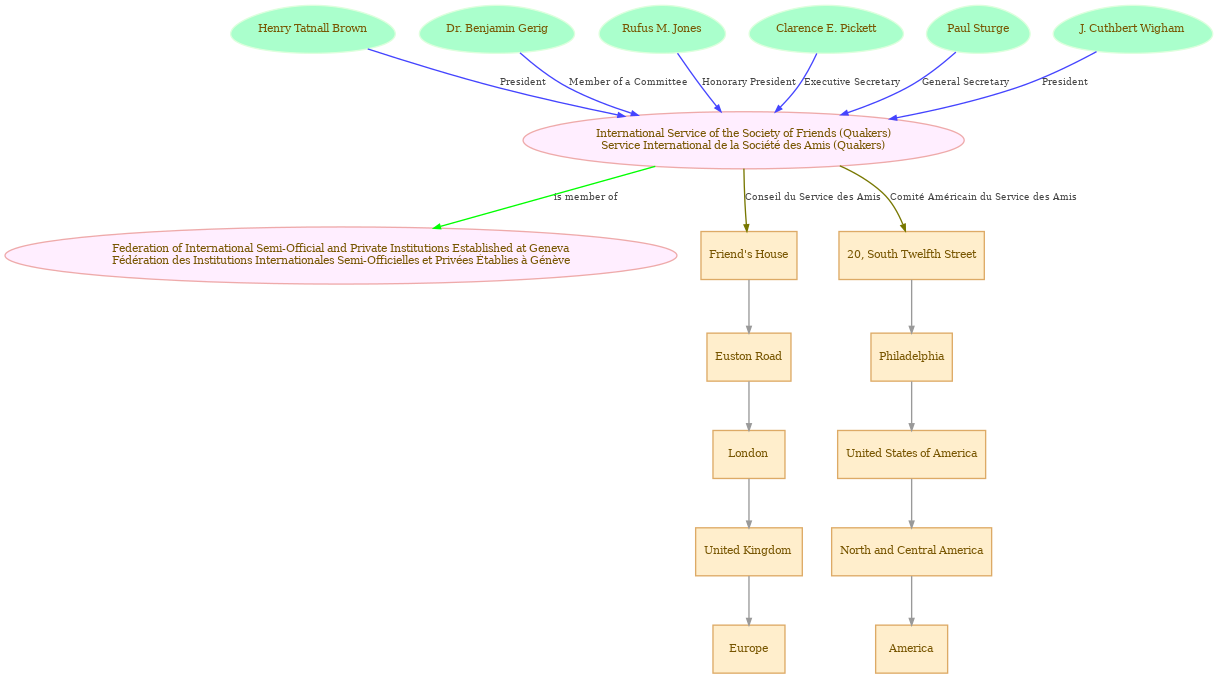




International Service of the Society of Friends (Quakers)
International Service of the Society of Friends (Quakers), Service International de la Société des Amis (Quakers)Founded: 1917
Sources: HB 1936, HB 1938
Officers
American Committee of the Society of Friends.- Henry Tatnall Brown President 1936 : American Committee of the Society of Friends.
- Dr. Benjamin Gerig Member of a Committee 1936-1938 : Information mentioned in "Federation of International Semi-Official and Private InstitutionsEstablished at Geneva/ Fédération des InstitutionsInternationales Semi-Officielles et Privées Établies à Génève" (HB 1936/38)
- Rufus M. Jones Honorary President (President) 1936 : American Committee of the Society of Friends.
- Clarence E. Pickett Executive Secretary (Secretary) 1936 : American Committee of the Society of Friends.
- Paul Sturge General Secretary (Secretary General) 1936 : Council of the Society of Friends.
- J. Cuthbert Wigham President 1936 : Council of the Society of Friends.
Seats
-
Friend's House: Euston Road: London: United Kingdom
Conseil du Service des Amis -
20, South Twelfth Street: Philadelphia: United States of America
Comité Américain du Service des Amis
Relationships with other Organisations
- this organisation (International Service of the Society of Friends (Quakers)) is member of Federation of International Semi-Official and Private Institutions Established at Geneva
General facts
HB 1936: Le Comité américain du Service des Amis a été établi en 1917, et il devait se charger de l'œuvre de secours et de relèvement économique entreprise en Europe au nom des Amis américains. Ce Comité a collaboré étroitement avec le Comité de secours aux victimes de la guerre des Quakers britanniques, durant la guerre, et, plus tard, avec le Conseil des Amis pour le Service international (appelé, depuis 1927, le Conseil du Service des Amis). En Angleterre, un mouvement conçu et lancé au milieu de la guerre européenne a abouti, en 1918, à la création d'un Conseil de Quakers pour le service international. Ce mouvement avait essentiellement pour objet d'essayer de faire connaître dans la vie publique, religieuse, sociale et internationale, les sentiments intimes des Quakers et de leurs amis. Le « Centre des Quakers » prêche le nouveau mode de vie : une humanité libre, aimant et voulant la paix, animée de sentiments amicaux, recherchant la coopération internationale et ayant une foi profonde dans l'influence active de l'élément divin dans l'homme. Les principaux centres de ce service sont actuellement à Londres, à Philadelphie, à Genève, à Paris, à Berlin et à Vienne. Chaque centre est devenu, selon l'intention de ses fondateurs, une maison des Amis. Si les dépenses de ces centres ont été surtout à la charge des pays où les Quakers et leurs amis sont les plus nombreux, les centres n'en ont pas moins été toujours internationaux. Cet internationalisme nouveau s'est étendu à de nombreuses œuvres des amis qui fonctionnent ailleurs. Brummana, en Syrie, dans les montagnes du Liban, au delà de Beyrouth, est devenu un centre international très actif. Cette même idée trouve son expression dans l'ancien Service missionnaire des Amis dans l'Inde, en Chine, à Madagascar et à Pemba, qui s'est à présent uni aux œuvres d'Europe, sous l'égide du Conseil actuel du Service des Amis. HB 1938: The American Committee of the Friends' Service was set up in 1917 for the work of relief and economic recovery in Europe on behalf of the American friends. This Committee collaborated closely with the Committee for the relief of war victims of the British Quakers during the war, and later with the Friends' Council for International Service (known since 1927 as the Council of the Friend's Service). In England, a movement planned and launched in the middle of the European war led in 1918 to the formation of a Quakers' Council for. International Service. The main object of this movement was to attempt to enlighten public, religious, social and international circles on the inner sentiments and aspirations of the Quakers and their friends. The Quakers' Centre teaches a new way of life: a free, loving and peace-loving humanity , inspired b y friendly sentiments, seeking international co-operation and having a deep faith in the active influence of the divine element in man. The principal centres of this service are now in London, Philadelphia, Geneva, Paris, Berlin and Vienna. Each centre has become a Friends' House, in accordance with the intentions of its founders. While the expenses of these centres have been borne mainly by the countries in which the Quakers and their friends are most numerous, they are none the less always international. This new form of internationalism was extended to numerous Friends' Societies elsewhere. Brummana, in Syria, in the Lebanese mountains above Beirut, has become a very active international centre. The same idea finds expression in the former Friends' Missionary Service in India, China, Madagascar and Pemba , which is at present connected with the European work, under the aegis of the present Council of the Friends' Service.Publications
HB 1936: The Wayfarer (comprenant le Quaker World Service), rédacteur: Edgar G. Dunston, Friends House, Euston Road, Londres, N.W.1. Bibliographie: "A Quaker Adventure", par A. Ruth Fry; "Quakers in Action", par Lester M. Jones (MacMillan Co., New York, 1929); "Quaker Adventures", par Edward Thomas (Fleming H. Réveil Co., 21 Paternoster Sq., Londres). HB 1938: The Wayfarer (including the Quaker World Service), Editor; Edgar G. Dunstan, Friends' House, Euston Road, London, N.W.I. Bibliography: A Quaker Adventure, by A. Ruth Fry; Quakers in Action, by Lester M.Jones (Mac Millan Co., New York, 1929); Quaker Adventures, by Edward Thomas (Fleming H . Revell Co., 21, Paternoster Sq., London), Annual Report Unity in Diversity, and survey of the service in various parts of the world.Network
